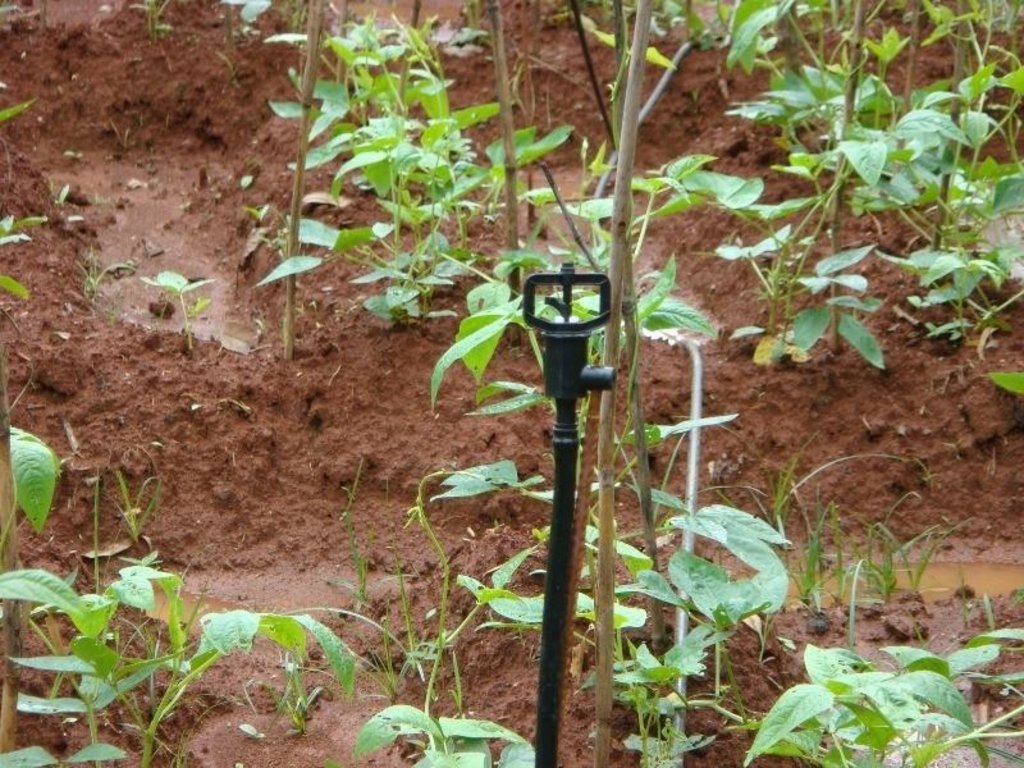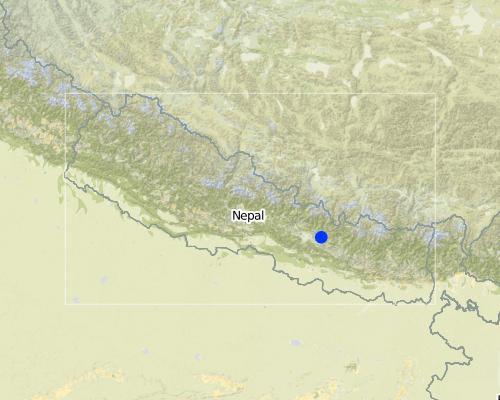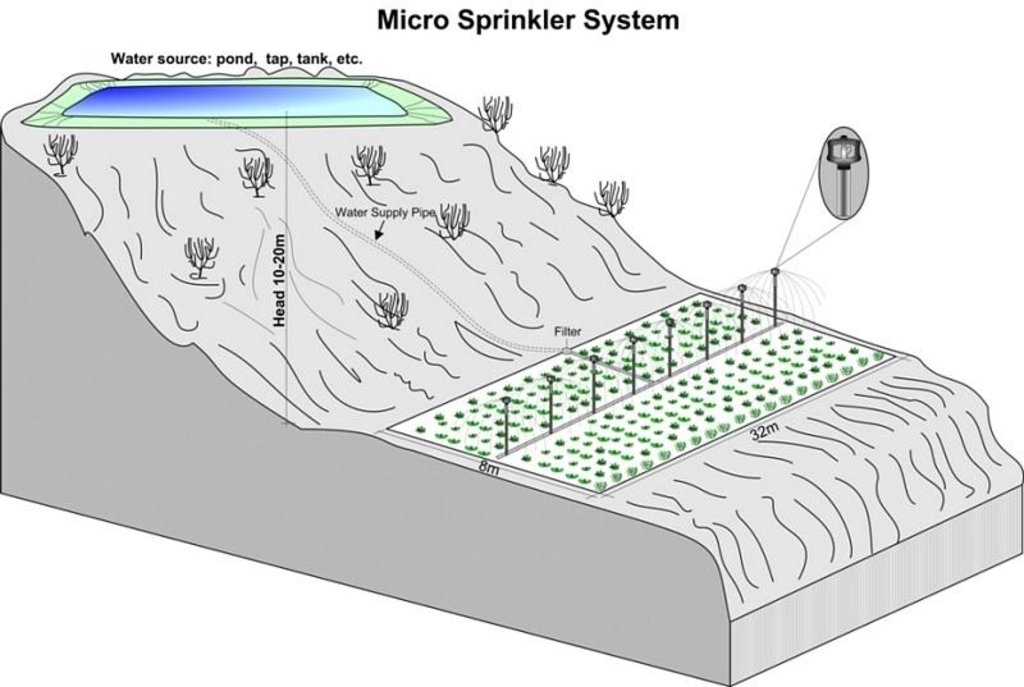Low cost micro-sprinkler irrigation [النيبال]
- تاريخ الإنشاء:
- تحديث:
- جامع المعلومات: Madhav Dhakal
- المحرر: –
- المُراجع: David Streiff
Phohara sinchai - Nepali
technologies_1500 - النيبال
عرض الأقسام
توسيع الكل طي الكل1. معلومات عامة
1.2 تفاصيل الاتصال بالأشخاص الرئيسيين لمصدر المعلومات والمؤسسات المشاركة في تقييم وتوثيق التقنية
متخصص في الإدارة المستدامة للأراضي:
متخصص في الإدارة المستدامة للأراضي:
اسم المؤسسة (المؤسسات) التي سهلت توثيق/تقييم التقنية (إذا كان ذلك على صلة)
ICIMOD International Centre for Integrated Mountain Development (ICIMOD) - النيبال1.3 الشروط المتعلقة باستخدام البيانات الموثقة من خلال WOCAT
متى تم تجميع البيانات (ميدانيا)؟:
24/11/2006
يوافق جامع المعلومات والشخص (لاشخاص) الرئيسي لمصدر المعلومات على الشروط المتعلقة باستخدام البيانات الموثقة من خلال WOCAT:
نعم
2. وصف تقنيةالإدارة المستدامي للأراضي
2.1 وصف مختصر للتقنية
تعريف التقنية:
An irrigation system that delivers small-sized water droplets through a rotating head allowing longer watering time with less runoff
2.2 وصف تفصيلي للتقنية
الوصف:
Micro-sprinkler irrigation is an efficient and alternative method of irrigation for high value cash crops. It has been demonstrated in the Jhikhu Khola watershed (JKW) in Nepal’s middle mountains by the People and Resource Dynamics in Mountain Watersheds of the Hindu Kush-Himalayas Project (PARDYP). The NGO International Development Enterprises (IDE-Nepal) has assisted private companies to assemble and
market micro-irrigation systems.
Micro sprinklers are available in a variety of configurations. They operate at a low-pressure, with water delivered at a pressure equivalent to 10-20m of head, and at a low discharge rate of 0.1-0.2 lps - equivalent to the average discharge of a 1/2 inch size public tap. A pre-assembled micro-irrigation system generally consists of 4 to 8 sprinkler heads at 4m intervals connected by half inch piping. Micro sprinklers are most suitable for closely cropped vegetables like onion and garlic.
PARDYP demonstrated, tested, and promoted the system to show land users the potential to use irrigation water very efficiently, which is important because water is in short supply for much of the year after the monsoon finishes in September. In the test area, much of the land is left fallow after the monsoon crops have been harvested as it is difficult to grow winter crops because of the lack of irrigation
water.
The system is easy to install and move around. It needs a reliable source of water, such as a water harvesting tank or a tap, located about 10-20m above the field to be irrigated. A water tank can be installed at the appropriate height to give an adequate water head. The preassembled micro-sprinkler heads are inserted into the ground on a support stand and are connected to the water source via a conveyance pipe. The water passes through a filter before entering the sprinkler heads to prevent the sprinklers becoming clogged up; the system needs regular cleaning.
2.3 صور التقنية
2.5 البلد/المنطقة/المواقع التي تم تنفيذ التقنية فيها والتي يغطيها هذا التقييم
البلد:
النيبال
مزيد من التفاصيل حول الموقع:
Kavrepalanchowk/ Jhikhu Khola watershed
Map
×2.6 تاريخ التنفيذ
في حالة عدم معرفة السنة بالتحديد، يرجى الإشارة إلى التاريخ التقريبي:
- منذ أقل من 10 سنوات (مؤخرًا)
2.7 إدخال التقنية
حدد كيف تم إدخال التقنية:
- من خلال المشاريع/ التدخلات الخارجية
التعليقات (نوع المشروع، الخ):
Pre-assembled micro-irrigation technology, which was demonstrated in the Which khola watershed, was developed by IDE/Nepal in 1998.
3. تصنيف تقنية الإدارة المستدامي للأراضي
3.1 الغرض الرئيسي ( الأغراض الرئيسية) للتقنية
- Improve efficiency of water use
3.2 نوع (أنواع) استخدام الأراضي الحالية حيث يتم تطبيق التقنية

الأراضي الزراعية
- زراعة سنوية
المحاصيل الرئيسية (المحاصيل النقدية والغذائية):
major cash crop: Tomato and potato
major food crop: Maize and wheat
other: Legumes and mustard
التعليقات:
Major land use problems (compiler’s opinion): Insufficient irrigation water during winter and the pre-monsoon season (November-May). Insufficient farm income due to small landholdings, and soil health deterioration due to increased inputs of chemical fertilisers and agrochemicals.
Major land use problems (land users’ perception): Irrigation water shortage for the crops grown during winter and premonsoon months.
Type of cropping system and major crops comments: Maize- Wheat /vegetables
3.3 مزيد من المعلومات حول استخدام الأراضي
إمدادات المياه للأرض التي يتم تنفيذ التقنية عليها:
- بعلية
عدد مواسم الزراعة في السنة:
- 3
حدد:
Longest growing period in days: 150; Longest growing period from month to month: Jun - Oct; Second longest growing period in days: 120; Second longest growing period from month to month: Nov - Feb
3.4 مجموعةالإدارة المستدامة للأراضي التي تنتمي إليها هذه التقنية
- إدارة الري (بما في ذلك إمدادات المياه والصرف الصحي)
3.5 انتشار التقنية
حدد انتشار التقنية:
- منتشرة بالتساوي على مساحة
إذا كانت التقنية منتشرة بالتساوي على منطقة ما، فحدد المنطقة التقريبية المغطاة:
- 0.1-1 كم2
3.6 التدابير التقنية في مجال إلادارة المستدامة للأراضي

التدابير الإدارية
- M2: تغيير في مستوى الإدارة/الكثافة
3.7 الأنواع الرئيسية من تدهور الأراضي التي تناولتها التقنية

تآكل التربة بالمياه
- الوزن(Wt): فقدان التربة السطحية/تآكل السطح
التعليقات:
Main type of degradation addressed: Wt: loss of topsoil / surface erosion
Main causes of degradation: change of seasonal rainfall
Secondary causes of degradation: droughts
3.8 منع أو حد أو عكس تدهور الأراضي
تحديد هدف التقنية فيما يتعلق بتدهور الأراضي:
- الحد من تدهور الأراضي
4. المواصفات الفنية، وأنشطة التنفيذ، والمدخلات، والتكاليف
4.1 الرسم الفني للتقنية
4.2 المواصفات الفنية/شروحات الرسم الفني
Micro-sprinkler irrigation system and
technical specification.
Location: Patalekhet and Kuttal. Kavrepalanchowk district
Technical knowledge required for field staff / advisors: low
Technical knowledge required for land users: low
Main technical functions: increase / maintain water stored in soil, water spreading ( efficiently)
Change of land use practices / intensity level: from conventional irrigation(flood/ bucket) to efficient irrigation.
4.3 معلومات عامة بخصوص حساب المدخلات والتكاليف
حدد كيفية احتساب التكاليف والمدخلات:
- لكل وحدة تقنية
حدد الوحدة:
Micro-sprinkler irrigation
حدد الحجم والطول وما إلى ذلك (إذا كانت ذات صلة):
4 to 8 sprinkler heads at 4 m intervals
حدد العملة المستخدمة لحساب التكاليف:
- دولار أمريكي
اذكر متوسط تكلفة أجر العمالة المستأجرة في اليوم الواحد:
2.10
4.4 أنشطة التأسيس
| النشاط | نوع التدبير | التوقيت | |
|---|---|---|---|
| 1. | Identify an appropriate water source (water harvesting tank, tap, pump) | إدارية | beginning of the growing season |
| 2. | Fix the micro-sprinkler heads in the ground with their support stands | إدارية | growing season |
| 3. | Connect sprinkler system with water source through conveyance pipes | إدارية | growing season |
4.5 التكاليف والمدخلات اللازمة للتأسيس
| تحديد المدخلات | الوحدة | الكمية | التكاليف لكل وحدة | إجمالي التكاليف لكل مدخل | % من التكاليف التي يتحملها مستخدمو الأراضي | |
|---|---|---|---|---|---|---|
| العمالة | Installing micro-sprinkler system | Persons/unit | 2,0 | 2,1 | 4,2 | 100,0 |
| معدات | Sprinkler heads, pipes etc. | unit | 1,0 | 12,2 | 12,2 | |
| إجمالي تكاليف إنشاء التقنية | 16,4 | |||||
التعليقات:
Duration of establishment phase: 6 month(s)
4.6 الصيانة/الأنشطة المتكررة
| النشاط | نوع التدبير | التوقيت/الوتيرة | |
|---|---|---|---|
| 1. | Regular monitoring of the sprinklers’ performance | إدارية | during irrigating period / regularly |
| 2. | Cleaning nozzles if clogging problem occurs | إدارية | during irrigating period / regularly |
4.7 التكاليف والمدخلات اللازمة للصيانة/للأنشطة المتكررة (سنويًا)
| تحديد المدخلات | الوحدة | الكمية | التكاليف لكل وحدة | إجمالي التكاليف لكل مدخل | % من التكاليف التي يتحملها مستخدمو الأراضي | |
|---|---|---|---|---|---|---|
| العمالة | Maintaining sprinkler system | Persons/unit | 1,0 | 2,1 | 2,1 | 100,0 |
| إجمالي تكاليف صيانة التقنية | 2,1 | |||||
التعليقات:
Machinery/ tools: measuring tape, hammer
The cost was calculated for unit technology with all necessary components (pipes, filter, fittings, stand ) and 4 micro sprinkler heads, which is sufficient to irrigate 250 sq. m. area. Cost estimated in 2006.
4.8 أهم العوامل المؤثرة على التكاليف
قدم وصفا لأهم العوامل التي تؤثر على التكاليف:
The system itself is a dominating factor affecting the cost.
5. البيئة الطبيعية والبشرية
5.1 المناخ
هطول الأمطار السنوي
- < 250 مم
- 251- 500 ملم
- 501 - 750ملم
- 1,000-751 ملم
- 1,500-1,100 ملم
- 2,000-1,500 ملم
- 3,000-2,001 ملم
- 4,000-3,100 ملم
- > 4000 ملم
حدد متوسط هطول الأمطار السنوي (إذا كان معروفًا)، بالملليمتر:
1070,00
المنطقة المناخية الزراعية
- رطبة
Thermal climate class: subtropics
5.2 طوبوغرافيا
متوسط الانحدارات:
- مسطح (0-2%)
- بسيط (3-5%)
- معتدل (6-10%)
- متدحرج (11-15%)
- تلال (16-30%)
- شديدة الانحدار(31-60%)
- فائقة الانحدار (>60%)
التضاريس:
- هضاب/سهول
- أثلام مرتفعة
- المنحدرات الجبلية
- منحدرات التلال
- منحدرات في السفوح
- قاع الوادي
المنطقة الارتفاعية:
- 100-0 متر فوق سطح البحر
- 500-101 متر فوق سطح البحر
- 1,000-501 متر فوق سطح البحر
- 1,500-1,001 متر فوق سطح البحر
- 2,000-1,501 متر فوق سطح البحر
- 2,500-2,100 متر فوق سطح البحر
- 3,000-2,501 متر فوق سطح البحر
- 4,000-3,001 متر فوق سطح البحر
- > 4000 متر فوق سطح البحر
5.3 التربة
متوسط عمق التربة:
- ضحل جدًا (0-20 سم)
- ضحلة (21-50 سم)
- متوسطة العمق (51-80 سم)
- عميقة (81-120 سم)
- عميقة جدًا (> 120 سم)
قوام التربة (التربة السطحية):
- متوسط ( طميي، سلتي)
- ناعم/ثقيل (طيني)
المواد العضوية في التربة السطحية:
- متوسطة (1-3%)
إذا كان متاحًا، قم بإرفاق وصف كامل للتربة أو تحديد المعلومات المتوفرة، على سبيل المثال نوع التربة، الرقم الهيدروجيني/ درجة حموضة التربة، قدرة التبادل الكاتيوني، النيتروجين، الملوحة وما إلى ذلك.
Soil fertility is very low - low
Soil drainage / infiltration is medium
Soil water storage capacity is medium
5.4 توافر المياه ونوعيتها
نوعية المياه (غير المعالجة):
مياه الشرب سيئة (تتطلب معالجة)
تعليقات ومواصفات أخرى بشأن نوعية المياه وكميتها:
Water quality (untreated): Also good drinking water. More in rainy season (June- September), less in April/May; source: natural spring
5.6 خصائص مستخدمي الأراضي الذين يطبقون التقنية
التوجه السوقي لنظام الإنتاج:
- مختلط (كفاف/ تجاري)
الدخل من خارج المزرعة:
- 10-50% من جميع الإيرادات
المستوى النسبي للثروة:
- ضعيف
- متوسط
أفراداً أو مجموعات:
- فرد/أسرة معيشية
مستوى المكننة:
- عمل يدوي
الجنس:
- نساء
- رجال
اذكر الخصائص الأخرى ذات الصلة لمستخدمي الأراضي:
Land users applying the Technology are mainly common / average land users
Population density: 200-500 persons/km2
Annual population growth: 2% - 3%
15% of the land users are rich and own 35% of the land.
50% of the land users are average wealthy and own 25% of the land (as classified by the land users).
35% of the land users are poor and own 40% of the land.
Off-farm income specification: In most farm households, off-farm income plays at least a minor and increasingly a major role. Occasional opportunities for off-farm income present themselves in the form of daily
Market orientation of production system: Mostly vegetables.
Level of mechanization: Only vegetables are grown with this technology.
5.7 متوسط مساحة الأرض المملوكة أو المستأجرة من قبل مستخدمي الأراضي الذين يطبقون التقنية
- < 0.5 هكتارا
- 0.5 - 1 هكتار
- 1 -2 هكتار
- 2 - 5 هكتار
- 5 - 15 هكتار
- 15 - 50 هكتار
- 50 - 100هكتار
- 500-100 هكتار
- 1,000-500 هكتار
- 10,000-1,000 هكتار
- > 10,000 هكتار
هل يعتبر هذا نطاقًا صغيرًا أو متوسطًا أو واسعا (في إشارة إلى السياق المحلي)؟:
- على نطاق متوسط
التعليقات:
Average area of land owned or leased by land users applying the Technology: Also 2-5 ha.
5.8 ملكية الأراضي، وحقوق استخدام الأراضي، وحقوق استخدام المياه
ملكية الارض:
- فردية، يوجد سند ملكية
حقوق استخدام الأراضي:
- فردي
حقوق استخدام المياه:
- وصول مفتوح (غير منظم)
6. الآثار والتصريحات الختامية
6.1 الآثار التي أظهرتها التقنية في الموقع
الآثار الاجتماعية والاقتصادية
الدخل والتكاليف
دخل المزرعة
التعليقات/ حدد:
due to increased vegetable production
الآثار الاجتماعية والثقافية
المؤسسات المجتمعية
التعليقات/ حدد:
an informal network of sprinkler users formed
المعرفة بالإدارة المستدامة للأراضي/تدهور الأراضي
livelihood and human well-being
التعليقات/ حدد:
vegetableproduction became possible with use of less water, production increased.
الآثار الايكولوجية
التربة
رطوبة التربة
التعليقات/ حدد:
due to precise delivery of water (0.1 - 0.2 lps)
فقدان التربة
التعليقات/ حدد:
due to uniform application of water to crops grown on slopping land
الآثار الايكولوجية الأخرى
Made the irrigation of multiple vegetables possible
التعليقات/ حدد:
as users can shift the system around to irrigate
6.3 تعرض التقنية وحساسيتها لتغير المناخ التدريجي والظواهر المتطرفة/الكوارث المرتبطة بالمناخ (كما يراها مستخدمو الأراضي)
تغير مناخ تدريجي
تغير مناخ تدريجي
| الموسم | نوع التغير المناخي/ المتطرف | كيف تتعامل التقنية مع ذلك؟ | |
|---|---|---|---|
| درجة الحرارة السنوية | زيادة | غير معروف |
الظواهر المتطرفة / الكوارث المرتبطة بالمناخ
الكوارث الجوية
| كيف تتعامل التقنية مع ذلك؟ | |
|---|---|
| عاصفة ممطرة محلية | جيدا |
| عاصفة هوائية محلية | ليس جيدا |
الكوارث المناخية
| كيف تتعامل التقنية مع ذلك؟ | |
|---|---|
| جفاف | جيدا |
الكوارث الهيدرولوجية
| كيف تتعامل التقنية مع ذلك؟ | |
|---|---|
| فيضان عام (نهر) | ليس جيدا |
العواقب الأخرى المتعلقة بالمناخ
العواقب الأخرى المتعلقة بالمناخ
| كيف تتعامل التقنية مع ذلك؟ | |
|---|---|
| انخفاض فترة النمو | جيدا |
6.4 تحليل التكلفة والعائد
كيف يمكن مقارنة العوائد نسبة لتكاليف الإنشاء (من وجهة نظر مستخدمي الأراضي)؟
عوائد قصيرة الأجل:
إيجابي قليلا
عوائد طويلة الأجل:
إيجابي
كيف تتم مقارنة العوائدمع كلفة الصيانة/التكاليف المتكررة (من وجهة نظر مستخدمي الأراضي)؟
عوائد قصيرة الأجل:
ايجابي جدا
عوائد طويلة الأجل:
ايجابي جدا
التعليقات:
The table shows the perceptions of land users who accepted the technology with incentives from the PARDYP project. The short-term benefits are positive even if users have to buy the system themselves.
6.5 اعتماد التقنية
- أكثر من 50%
إذا كان متاحًا، قم بتحديد الكمية (عدد الأسر المعيشية و/أو المساحةالمغطاة):
515 households in an area of 0.1 - 1 sq km. (200 - 500 persons / sq km)
من بين جميع الذين تبنوا التقنية، كم عدد الذين فعلوا ذلك بشكل تلقائي، أي دون تلقي أي حوافز مادية/مدفوعات؟:
- 100-90%
التعليقات:
3% of land user families have adopted the Technology with external material support
15 land user families have adopted the Technology with external material support
Comments on acceptance with external material support: survey results
97% of land user families have adopted the Technology without any external material support
500 land user families have adopted the Technology without any external material support
Comments on spontaneous adoption: survey results
There is a strong trend towards spontaneous adoption of the Technology
Comments on adoption trend: About 80% of the implementers explained that they have seen neighbors using the sprinkle system so there is a growing trend of adoption. Some farmers were using the technology even before it was introduced by the project.
6.7 نقاط القوة / المزايا / الفرص التي توفرها التقنية
| نقاط القوة/ المزايا/ الفرص من وجهة نظر مستخدمي الأراضي |
|---|
| Sprinkler showers drive away insects |
| Is equally useful to irrigate fallow land to increase soil moisture. |
| نقاط القوة/ المزايا/ الفرص من وجهة نظر جامع المعلومات أو غيره من الاشخاص الرئيسيين لمصدر المعلومات |
|---|
|
Extremely useful for closely spaced, leafy vegetables such as onions, garlic and spinach grown in small areas. How can they be sustained / enhanced? Suitable for row crops like bitter gourd during their initial stage of growth; and also good for a wide range of row crops (tree crops and vegetables) that require low-fl ow irrigation. |
|
Most appropriate for sloping land How can they be sustained / enhanced? Can be used on level land if tank placed at appropriate height |
|
Easy to transport, and possible to use for different crops in rotation How can they be sustained / enhanced? Position of the sprinkler head should be changed to acquire 100% overlap of watered areas. |
|
Allows uniform distribution of water and longer watering time with less runoff; therefore reduces soil loss from sloping land and increases soil moisture status. How can they be sustained / enhanced? The technology should be shared with a wider audience |
6.8 نقاط ضعف / مساوىء / مخاطر التقنية وسبل التغلب عليها
| نقاط الضعف/ المساوىء/ المخاطر من وجهة نظر مستخدم الأراضي | كيف يمكن التغلب عليها؟ |
|---|---|
| Sometimes sprinklers stop functioning as they do not rotate and can become disconnected from the pipe | Regular checking and cleaning |
| Are susceptible to being stolen as they can be easily dismantled | Regular site visits by the farmer |
| نقاط الضعف/ المساوىء/ المخاطر من وجهة نظر جامع المعلومات أو غيره من الاشخاص الرئيسيين لمصدر المعلومات | كيف يمكن التغلب عليها؟ |
|---|---|
| Requires sufficient head pressure therefore less suitable for plain lands. | It can be used in plain lands with alternative arrangements i.e. by constructing a platform for drum/ tank at appropriate height. |
7. المراجع والروابط
7.2 المراجع للمنشورات المتاحة
العنوان، المؤلف، السنة، النظام القياسي الدولي لترقيم الكتب ISBN:
ICIMOD (2007) Good Practices in Watershed Management, Lessons Learned in the Mid Hills of Nepal. Kathmandu: ICIMOD
متاح من أين؟كم التكلفة؟:
ICIMOD
الروابط والوحدات المواضيعية
توسيع الكل طي الكلالروابط
لا يوجد روابط
الوحدات المواضيعية
لا يوجد وحدات مواضيعية





